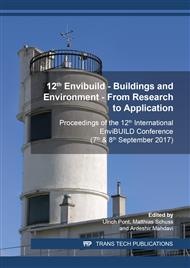[1]
T.J. Freeman, Evaluation of the Typical Meteorological Years, for Solar Heating and Cooling System Studies – Final Report, Solar Energy Research Institute, Golden, CO, (1979).
DOI: 10.2172/5626678
Google Scholar
[2]
R. Aguiar, S. Camelo, H. Gonçalves, Assessing the Value of Typical Meteorological Years Built from Observed and from Synthetic Data for Building Thermal Simulation, Proceeding of the 6th international IBPSA conference, Kyoto, Japan, September 13–15 (1999).
Google Scholar
[3]
H. Lund, The Design Reference Year, Proceedings of the 3rd international IBPSA conference, Nice, France, August 20–22 (1991).
Google Scholar
[4]
H. Lund, The Design Reference Year Users Manual, DTU Thermal Insulation Laboratory, Copenhagen, Denmark, (1995).
Google Scholar
[5]
I.J. Hall, R.P. Richard, E.A. Herbert, C.B. Eldon, Generation of Typical Meteorological Years for 26 SOLMET Stations. Technical Report SAND – 78-1601, Sandia Laboratories, Albuquerque, NM, (1978).
Google Scholar
[6]
J.M. Finkelstein, R.E. Schafer, Improved Goodness-of-Fit Tests, Biometrika 58:3 (1971) 641–645.
DOI: 10.1093/biomet/58.3.641
Google Scholar
[7]
W. Marion, K. Urban, User's Manual for TMY2 – Typical Meteorological Years, National Renewable Energy Laboratory, Golden, CO, (1995).
Google Scholar
[8]
S.M. Wilcox, W. Marion, Users Manual for TMY3 Data Sets, National Renewable Energy Laboratory, Golden, CO, (2008).
DOI: 10.2172/928611
Google Scholar
[9]
CEN (European Committee for Standardization), EN ISO 15927-4:2005 – Hygrothermal Performance of Buildings – Calculation and Presentation of Climatic Data – Part 4: Hourly Data for Assessing the Annual Energy Use for Heating and Cooling, European Committee for Standardization, Brussels, Belgium, (2005).
DOI: 10.3403/30114395
Google Scholar
[10]
L. Yang, J.C. Lam, J. Liu, Analysis of Typical Meteorological Years in Different Climates of China, Energy Conversion and Management 48:2 (2007) 654–668.
DOI: 10.1016/j.enconman.2006.05.016
Google Scholar
[11]
T. Kalamees, K. Jylhä, H Tietäväinen, J. Jokisalo, S. Ilomets, R. Hyvönen, S. Saku, Development of Weighting Factors for Climate Variables for Selecting the Energy Reference Year According to the EN ISO 15927-4 Standard, Energy and Buildings 47 (2012) 53–60.
DOI: 10.1016/j.enbuild.2011.11.031
Google Scholar
[12]
G. Pernigotto, A. Prada, A. Gasparella, J.L.M. Hensen, Analysis and Improvement of the Representativeness of EN ISO 15927-4 Reference Years for Building Energy simulation, Journal of Building Performance Simulation 7:6 (2014) 391-410.
DOI: 10.1080/19401493.2013.853840
Google Scholar
[13]
P. Narowski, M. Janicki, D. Heim. Comparison of Untypical Meteorological Years (UMY) and Their Influence on Building Energy Performance Simulation, Proceedings of the 13th international IBPSA conference, Chambéry, France, 26-28 August (2013).
DOI: 10.26868/25222708.2013.1466
Google Scholar
[14]
D.B. Crawley, L.K. Lawrie, Rethinking the TMY: is the Typical' Meteorological Year best for Building Performance Simulation,, Proceedings of the 14th international IBPSA conference, Hyderabad, India, 7-9 December (2015).
DOI: 10.26868/25222708.2015.2707
Google Scholar
[15]
D.B. Crawley, Estimating the Impacts of Climate Change and Urbanization on Building Performance, Journal of Building Performance Simulation 1:2 (2008) 91-115.
DOI: 10.1080/19401490802182079
Google Scholar
[16]
R.A. Cox, M. Drews, C. Rode, S. Balslev Nielsen, Simple Future Weather Files for Estimating Heating and Cooling Demand, Building and Environment 83 (2015) 104-114.
DOI: 10.1016/j.buildenv.2014.04.006
Google Scholar
[17]
R.A. Gansler, S.A. Klein, W.A. Beckman, Assessment of Accuracy of Generated Meteorological Data for Use in Solar Energy Simulation Studies, Solar Energy 53:3 (1994) 279–287.
DOI: 10.1016/0038-092x(94)90634-3
Google Scholar
[18]
A.A. Argiriou, S.P. Lykoudis, S. Kontoyiannidis, C.A. Balaras, D.N. Asimakopoulos, M.C. Petrakis, P.A. Kassomenos, Comparison of Methodologies for TMY Generation Using 20 Years Data for Athens, Greece, Solar Energy 66:1 (1999) 33–45.
DOI: 10.1016/s0038-092x(99)00012-2
Google Scholar
[19]
J. Bilbao, A. Miguel, J.A. Franco, A. Ayuso, Test Reference Year Generation and Evaluation Methods in the Continental Mediterranean Area, Journal of Applied Meteorology 43:2 (2004) 390–400.
DOI: 10.1175/1520-0450(2004)043<0390:trygae>2.0.co;2
Google Scholar
[20]
G. Pernigotto, A. Prada, D. Cóstola, A. Gasparella, J.L.M. Hensen, Multi-Year and Reference Year Weather Data for Building Energy Labelling in North Italy Climates, Energy and Buildings 72 (2014) 62–72.
DOI: 10.1016/j.enbuild.2013.12.012
Google Scholar
[21]
G. Antonacci, I. Todeschini, Derivation of Meteorological Reference Year with Hourly Interval for Italy, Proceedings of Building Simulation Application – 1st IBPSA – Italy conference, Bolzano, Italy, January 30 – February 1 (2013).
Google Scholar
[22]
WMO (World Meteorological Organization), Guide to Meteorological Instruments and Methods of Observation – WMO–No. 8, World Meteorological Organization, Geneva, Switzerland, (2008).
DOI: 10.1093/law:epil/9780199231690/e577
Google Scholar
[23]
A. Prada, Energy Performance of Buildings: Modeling of Dynamic Summer Behavior, PhD thesis, University of Trento, Trento, Italy, (2012).
Google Scholar
[24]
CEN (European Committee for Standardization), EN ISO 13790:2008 – Energy Performance of Buildings – Calculation of Energy Use for Space Heating and Cooling, European Committee for Standardization, Brussels, Belgium, (2008).
Google Scholar
[25]
UNI (Ente Nazionale Italiano di Normazione), UNI/TS 11300-1:2014 – Energy Performance of Buildings Part 1: Evaluation of Energy Need for Space Heating and Cooling, Ente Nazionale Italiano di Normazione, Milan, Italy, (2014).
Google Scholar
[26]
CEN (European Committee for Standardization), EN ISO 6946:2007 – Building Components and Building Elements. Thermal Resistance and Thermal Transmittance. Calculation Methods, European Committee for Standardization, Brussels, Belgium, (2007).
DOI: 10.3403/30313347
Google Scholar


